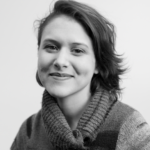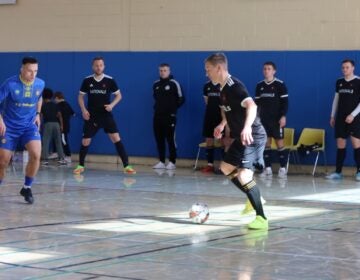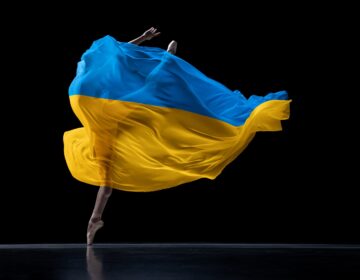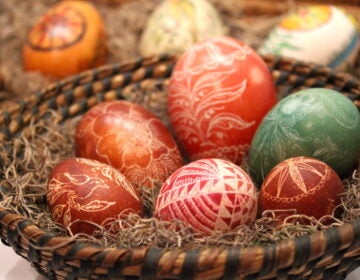Glencairn Museum spotlights a sacred Ukrainian tradition
Glencairn Museum is celebrating the rushnyk, a sacred Ukrainian tradition cherished by many Ukrainian Americans in the Greater Philadelphia region.
From Philly and the Pa. suburbs to South Jersey and Delaware, what would you like WHYY News to cover? Let us know!
A new exhibition at Glencairn Museum in Bryn Athyn explores the significance of the rushnyk, a sacred Ukrainian embroidery tradition practiced by many Ukrainian American families in the Greater Philadelphia region.
The Ukrainian word “rushnyk,” or its plural form “rushnyky,” refers to a regular towel or, in this case, a ritual embroidered cloth that plays an important role in key life events, including births, weddings and deaths.
Many Ukrainian homes feature rushnyky draped over family photographs and religious icons. There’s even a Ukrainian proverb summarizing the textile’s importance: “A house without a rushnyk is not a home.”
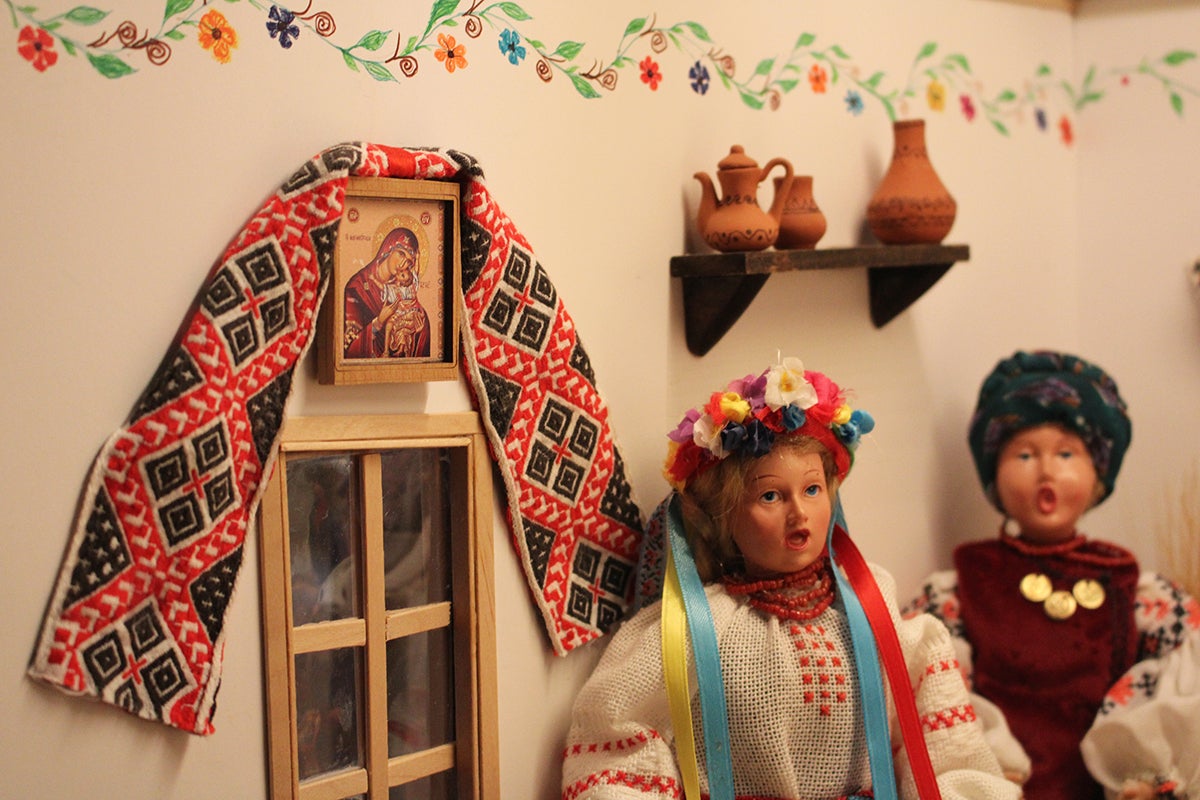
The Glencairn Museum exhibit is displaying rushnyky from different time periods and regions in Ukraine through Nov. 9. The textiles belong to the private collection of Franklin Sciaccia, emeritus associate professor of Russian language and literature at Hamilton College in New York.
Sciaccia said the endurance of rushnyky is a testament to the resilience of Ukrainian culture amid war, struggle, cultural oppression and genocide.
“After all the period of wars, of collectivization, of the Holodomor, of the famine of the 1930s … this tradition remains alive and active in Ukraine, and to a large degree in Ukrainian American communities,” he said.
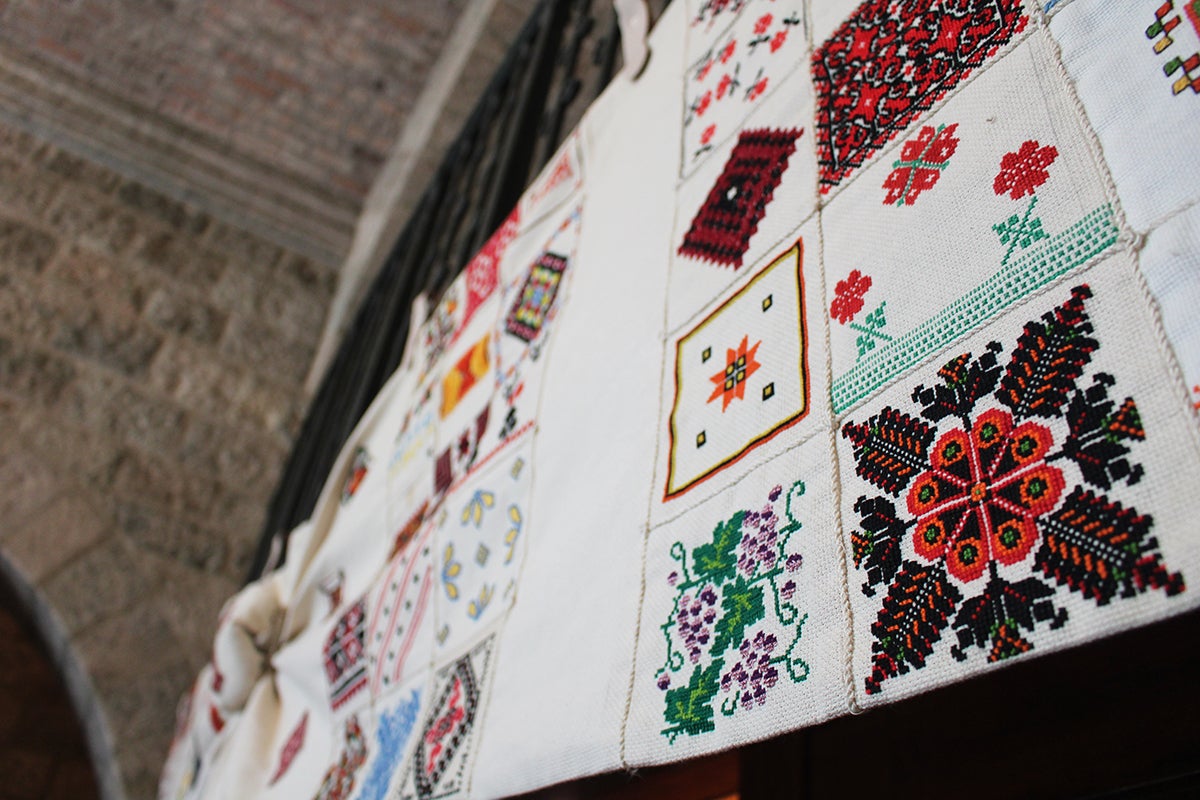
Rushnyky ‘a part of our being’ for Ukrainian immigrants
Chrystyna Prokopovych, curator of the Ukrainian Heritage Studies Center at Manor College, said rushnyky can be found in many of the homes of the more than 100,000 Ukrainians and Ukrainian Americans who call Pennsylvania home. Pennsylvania has the second-largest population of Ukrainian Americans of any state in the country.
“In my family and in the families of my friends and acquaintances, the rushnyk has always played a very prominent part in our daily life,” she said.
Prokopovych said her parents, who emigrated to the Greater Philadelphia region from Ukraine after World War II, were intent on preserving the tradition, along with other elements of Ukrainian culture.
“During the wedding, baptism, even the engagement, the rushnyk has a role,” Prokopovych said. “Embroidery, in general, was very, very important to us, and it was a part of what they left behind when they came from Ukraine. And for us, it is something that is just a part of our culture, a part of our being at this point.”
Tania Diakiw O’Neill, a Philadelphia-based author who presented at the opening of the exhibition, has written a bilingual how-to book on Ukrainian embroidery techniques, featuring over 100 traditional stitches. She said the embroidery of rushnyky is a specific skill and one that, in her work, she has sought to preserve.
“We have survived and managed to keep much of our culture and traditions,” she said. “The people retain their traditions, keep their culture as best they can even under oppression and pressure to become something else.”

Weaving family lores and rituals
Sciaccia’s interest in the Ukrainian tradition grew out of his curiosity about his family heritage: His maternal grandparents were Ukrainian, and emigrated to the United States around 1910.
After the collapse of the Soviet Union in 1991, Sciaccia traveled to his grandmother’s home town of Bazaliya, in western Ukraine. There, he learned about the rushnyky tradition thanks to a bit of family lore.
His grandmother, he said, was actually engaged to someone in the town in a ceremony that involved a ritual in which a rushnyk was wrapped around the couple’s hands to bind them together in matrimony.
However, Sciaccia’s grandmother didn’t want to marry the man, and left the village “in shame.”
“That’s where I first learned of that terminology, and first became entranced by the notion that there was this little bit of family scandal, right?” Sciaccia said. “That they remembered, like 100 years later, that they were still talking about it. Because, of course, it was a scandal, not only for her individually, but for an entire family, because these engagement ceremonies would usually ritually bind two families together.”

Rushnyky design and themes vary depending on the region. In the western part of the country, for example, there is a preference for geometric forms, Sciaccia said, while in central regions there’s more figurative use and a vocabulary of symbols, such as the tree of life. An embroidered plant or tree represents Earth as the source of life, and for rushnyky used in wedding ceremonies, there are depictions of trees surrounded by pairs of birds that represent the fidelity of the bridal couple.
The symbols and tradition itself predate Christianity, Sciaccia said.
“The whole concept of weaving and spinning, or spinning and weaving, is ancient, is pre-Christian,” he said. “It’s very well attested in ancient Greek thinking, you know, the fates spin life, the fate of destiny … Human beings in general, I think you’ve always had a conception that fabric and the creation of fabric is in some way a sacred ritual act. It in some way mimics the creation of the world.”
After the spread of Christianity, in some contexts, the tree became a cross and the Christian symbol serves as the “new concept of the tree of life,” Sciaccia said.
Other popular motifs are wreaths, or full circles, often used on funeral rushnyky to symbolize a completed circle.
Some rushnyky feature text and inscriptions, such as “God grant me happiness.” Other writings are songs that talk about the death of a loved one, especially for soldiers who die outside of their villages and who are mourned without a body to bury. That specific kind of rushnyk serves as a “memetic grave,” Sciaccia said.
The rushnyky used to wrap a newborn infant, in contrast, are often plain and unadorned or minimally adorned.
“I have never been able to collect one of those,” Sciaccia said. “Those tend really, really to remain within families, and probably are used until they’re no longer usable.”
Rushnyky and a national identity
In the years following the collapse of the Soviet Union, rushnyky played a key role in the creation of the independent Ukrainian state. A Rushnyk of National Unity was paraded through every region of Ukraine, with women adding lengths of cloth to it representing typical colors and motifs from their region.
“This was a means, using the powerful image of the rushnyk, to represent, you know that we are, in fact, now, one united nation, regardless of regional variations,” Sciaccia said. “And we put all our symbols right next to each other as a beautiful landscape, if you will, of the Ukrainian land.”
The creation process for rushnyky has changed, Sciaccia said. People don’t spin linen, and it’s not as common to find hand-embroidered pieces. There are shops now where you can buy either embroidered rushnyky or even mass-produced rushnyky that have images printed on polyester cloth.
“They’re really cheap. They’re really tacky looking, right?” Sciaccia said. “When you compare them to the beautiful, handmade and hand-loomed linen. And yet, the thing, to my mind, that makes that even one of the more interesting objects in the exhibition, is that the tradition is preserved.”
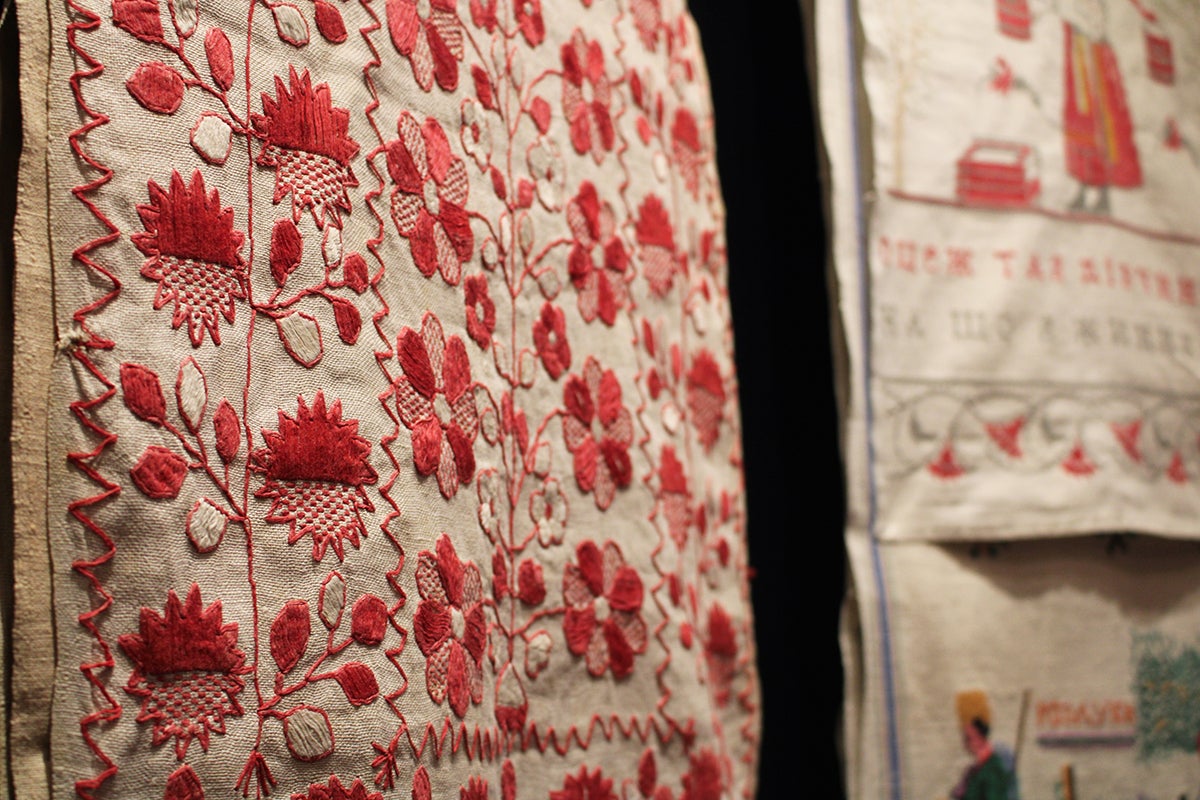
The Rushnyk of Hope
At the exhibition opening at Glencairn Museum on April 5, members of the local Ukrainian American communities participated in the celebration — and contributed to the display.
Jahnna Henderson, marketing and public relations manager at Glencairn Museum, said from the beginning, it was important to the museum to involve the local community.
“We’ve been trying to make connections with the Ukrainian community since [deciding to do the exhibition], just to make sure that we had a source community that we knew what we were talking about and that they could teach us,” she said. “We don’t want to misinterpret anything. We want to make sure that they felt comfortable with everything we were putting out.”
After she found out about the exhibition, Orysia Hewka, former executive director of the Ukrainian Educational and Cultural Center, decided to bring the Rushnyk of Hope out of storage. Now hanging over an icon, also provided by Hewka, at Glencairn Museum, the textile is a tapestry of patches contributed by 100 Ukrainian Americans — spanning three generations of Hewka’s own family — who sent embroidered squares to Hewka to create the collective rushnyk in 2007.
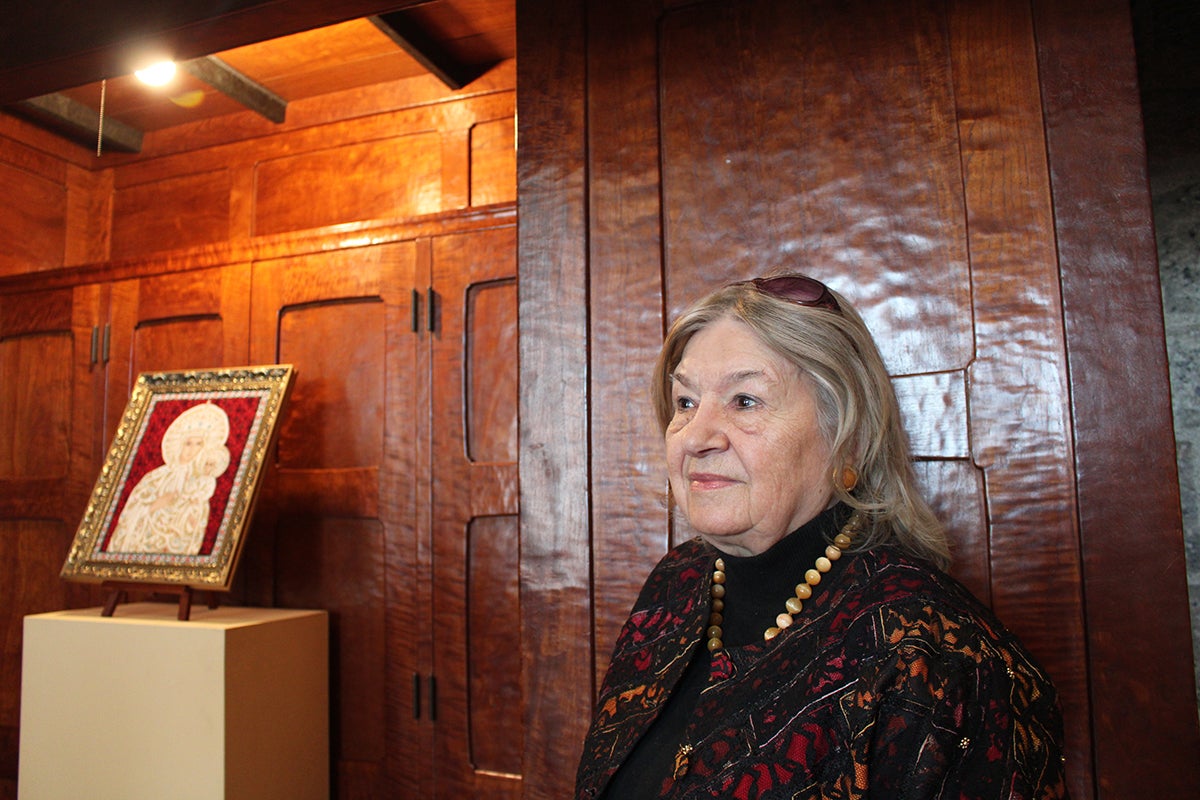
It was an “emotional experience,” Hewka said, to see it displayed once again at Glencairn Museum.
“Ukrainian history has been just spattered with tragedies and wars and looking for freedom, looking for expression,” she said, so she was thinking at the time about how to create “hope for a better future.” Then the idea came to her like “a bolt of lightning” to create a collective rushnyk.
“Rushnyk is a covering of prayer, a covering over us for our families,” she said.

That sense of covering and protection is more important than ever, Hewka said, as Russia’s full-scale invasion of the country continues into its fourth year.
For Ukrainian Americans in the region, the recent war has brought more attention and awareness to their culture and heritage.
Prokopovych, of the Ukrainian Heritage Studies Center at Manor College, said when she was in high school and even into college, few people knew about Ukraine, which at the time was part of the Soviet Union. Since the most recent Russian invasion began in February 2022, “everybody in the United States knows Ukraine.”
“People are calling. People are coming in to see the artifacts here in the museum,” she said.
Places like the Ukrainian Heritage Studies Center, along with the Ukrainian Educational and Cultural Center, serve an important role for newly-arrived immigrants and refugees fleeing the war.
“There’s definitely an interest in the museum, because it makes them feel like they’re at home,” Prokopovych said.
Natalie Firko, president of the Ukrainian Educational and Cultural Center, said enrollment in Ukrainian classes at their Ukrainian Heritage School has grown by more than 150 students since the war started. There are more Ukrainian community members who come by the center looking for resources and support.
Prokopovych said she is “very worried” about the ongoing conflict, especially after President Donald Trump’s exchange with Ukrainian President Volodomyr Zelenskyy at a meeting in February.
Hewka said the war is “devastating” in its cost to human life and its impact on Ukrainian national identity and history.
“The fact that a neighbor from the north feels that we have no right to exist and [is] trying to kill our churches, shelling the museums, stealing icons from museums, things we know that are happening,” she said.

Firko said exhibitions like the rushnyky show at Glencairn send an important message to Ukrainian Americans in the region.
“I think it shows our community members, and the most recent ones from Ukraine, that they are important and they are heard and they are known about, and there are people who care,” she said. “Coming from Ukraine, they didn’t really see that all the time, if they don’t have connections … but now they see how a lot of people in America really do care, and they have an interest. So that’s always comforting.”
Prokopovych said that art as a whole plays an important role even in the midst of the pressing fears and trials of war.
“I think it’s very important to continue with exhibits, with workshops, because the more people learn about any different country or culture, the more they can understand it and appreciate what the people of that culture experience,” she said. “They can sympathize with what’s going on in Ukraine and what’s going on with the people that are here, that still have relatives there or friends there.”


Get daily updates from WHYY News!
WHYY is your source for fact-based, in-depth journalism and information. As a nonprofit organization, we rely on financial support from readers like you. Please give today.


